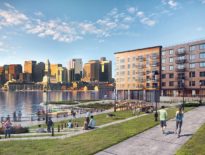
Susan Gittelman
Housing in Greater Boston is expensive to build. The costs of land, material and labor continue to be on the rise, seemingly with no relief in sight.
Energy efficiency, sustainability and resiliency measures – connected to addressing the real effects of climate change – are important elements for safeguarding the operations of multi-family housing.
A big question is: How can affordable housing be built to operate to high efficiency standards, enduring into an uncertain climate future?
In a few cases it is happening, but these are the exceptions. Currently, the resources available to achieve these goals are falling short of the costs to meet them.
Resources Fall Short of Goals
In general, developers struggle to secure the many sources of financing needed to build affordable housing. Equity raised through low income tax credits is still the main source of funding, and competition for those is fierce. There are targeted grant resources from agencies like the Mass Clean Energy Center and incentives from MassSave and others, but they are small in comparison to the expense.
On the cost side, to be competitive for these scarce resources, developers are responsive to many considerations, including meeting per–unit cost constraints while ensuring affordability levels and supplying a mix of unit sizes. They also must meet workforce goals and accessibility guidelines, satisfy building codes and “stretch codes” that call for better materials and construction techniques, and address more recent concerns about making buildings climate resilient.
“It’s not one thing that drives these costs,” a developer told me. “It’s cumulative. And if you miss the mark and go over budget, you have to cut somewhere.”
About a dozen states now include Passive House as a goal. Passive House, a set of practices and standards that originated in Germany, is desirable because its standards are generally higher than what are required by many states, including Massachusetts. It is considered a pathway to structures that are net–zero or even net–positive in their use of energy.
Pursuing goals such as the U.S. Building Council’s LEED standard or Passive House for multifamily housing adds cost to development in today’s market. Contractors often have to hire a specialist in the intricacies of meeting standards. Additional costs include added hours for design, plans that are more detailed, more meetings integrating design, mechanical and construction teams, and extensive modeling to make sure the building meets required performance thresholds.
While these goals are laudable, they add significant costs. Some say Passive House currently adds roughly $25,000 per unit.
Success Stories Show Need for Resources
In spite of the challenges, there have been some notable successes.
Homeowner’s Rehab Inc., a Cambridge-based nonprofit owner and developer of affordable housing, is currently constructing Concord Highlands, which is described as the largest new affordable housing development in that city in 40 years. It will provide 98 permanently affordable apartments.
The development “is aiming for the highest levels of resiliency and sustainability through high quality materials, energy efficient equipment, and a podium-style building structure to meet Enterprise Green Communities and Passive House standards,” HRI said.
But Cambridge is unusual in that it is committed to sustainability and is finding ways, through attempted zoning changes and leveraging its white–hot investment market, to help builders of affordable housing succeed.
These investments not only lower utility bills but also enhance the living environment and the building’s overall resiliency. An apartment building constructed with tight insulation, for example, will not only be cheaper to heat but also, in a time of extreme weather and power outage, retain heat for a much longer period, allowing residents to be comfortable for as much as four or five days, one experienced developer said.
For these reasons, there continue to be efforts in the design and construction industries to find cheaper ways to incorporate these changes to fulfill the broader mandate.
“Developers are responding to ever-increasing requirements,” one told me. “We are conscious of the costs it takes to get there.”
And there is a strong will within the affordable housing sector to further our climate readiness. Yet, while the benefits are becoming clearer, the question of how to pay for it in the context of our larger cost challenges is not so clear.
The recent climate events remind us of the urgency of bringing necessary resources to bear.
Susan Gittelman is the executive director of B’nai B’rith Housing, a nonprofit, affordable housing developer currently working in Boston, Sudbury, and Swampscott.





